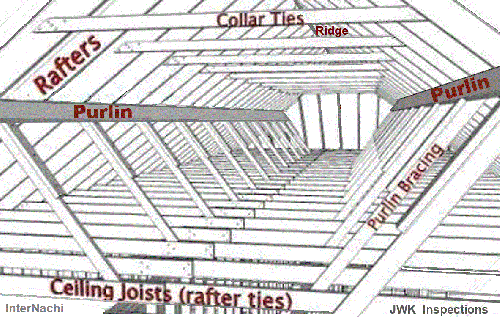

This is why the vast majority of new homes are built with trusses. Trusses are fast to install, do not require advanced skills, and can be designed for most applications. What Are the Advantages Of Using Trusses? This allows the builder to add roof components as needed to not only build the best-looking project but ensure the structure is structurally stable as well.

#Collar ties vs rafter ties code#
Because rafters can be modified on-site (assuming they still meet building code requirements), they are usually the best solution. This can be an insurmountable problem if the original home has settled or was not correctly built. However, in some remodeling projects, using trusses is very difficult or even impossible, because the original roof must be matched precisely. This is especially evident when the design is relatively simple, like a gable roof. For example, most new construction projects will employ trusses because the structure only needs to support its own weight. In the vast majority of applications, rafters are used to either solve a complex support concern or when an existing structure is being modified. This is not generally possible using rafters, which is why older architecture popularized visible beams, weight bearing walls, and columns. Some designs are so complex that the structure cannot be built without the use of trusses.įor example, trusses can be designed so that structural support can be hidden within a second floor system, eliminating the need for arches, beams, and posts. Journeyman carpenters (the highest skill level) are often required to navigate the complex structural requirements of a stick built home. However, this process can be slow and require much more skill and experience than installing trusses. What Are the Disadvantages Of Using Rafters?īuilding rafters and other roof components by hand is the traditional method of constructing a roof system. In these instances, building rafters and other roofing components on site saves time, effort, and most importantly, improves quality. Some situations require small tweaks to the framing to close small gaps or square up a section. It should be noted however, that trusses are not adjustable. As such, most will employ trusses wherever possible.
#Collar ties vs rafter ties professional#
During normal construction, professional builders are primarily interested in speed while maintaining quality construction. Rafters have the advantage of being customizable on site. What Are the Advantages Of Using Rafters? Smaller trusses used on smaller homes can sometimes be installed with simple labor, but in most situations, a crane will actually be more cost-effective. However, in the majority of new construction, trusses will require the use of a crane. Most new homes built today incorporate trusses instead of rafters and other components, because they are much faster and simpler to install. This opens up many more design options, as often weight-bearing walls can be reduced or eliminated. Trusses use components similar to an expansion bridge to span much larger distances than are generally possible with rafters. This makes trusses not only fast to install, but in most designs, easier. While rafters rely on joists and other components for support, trusses are mostly self-supporting. This chord will usually extend from an exterior wall to the gable, just like a rafter. Trusses also establish this pitch, but the board in a truss that performs the function of a rafter is called a chord. This is important because the pitch will establish the look and functionality of the roof, not to mention the amount of roofing materials needed. Roof rafterįor example, if a roof’s vertical measurement rises 4’ in height for every 12’ in length, the roof would be said to have a 4/12 pitch. Rafters establish the angle of the roof, which is expressed as a ratio of height to length. However, while trusses can essentially stand alone and perform their function, rafters only make up one component of a roof system. In a sense, yes, rafters and trusses have the same purpose. Do Rafters and Trusses Do the Same Thing? Trusses are generally custom built in a factory based on the job they must perform, and delivered to the job site ready to install. When professionals discuss “stick building”, they are referring to the traditional method of building a roof system on-site using rafters, joists, and other components. Trusses, however, incorporate nearly all of these components into a ready-made unit. Rafters are just one component in a roof system, along with collar ties, ceiling joists, rafter ties, strong backs, and weight-bearing walls. Both rafters and trusses can form the framework of a roof system, but they can be used very differently. If you have ever wondered what the difference is between a rafter and a truss, you’ve come to the right place.


 0 kommentar(er)
0 kommentar(er)
